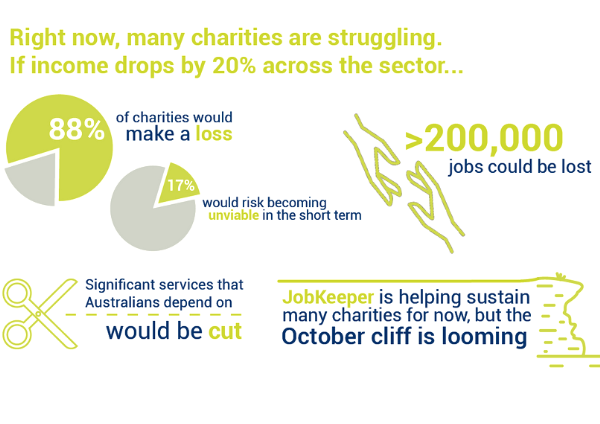SVA and CSI COVID charity financial health check

“Even before the COVID-19 crisis, the charity sector was working with an operating model that was on the brink. It has been constrained by rising costs, increased demand, a lack of financial flexibility, and chronic underfunding of services…
This analysis shows that there is real risk that the crisis could push many organisations beyond the point where they’re financially viable. If they remain afloat via major cuts in expenses, the losses in both employment and service delivery capacity will be significant.”
Social Ventures Australia (SVA) and the Centre for Social Impact (CSI) have teamed up to model the potential impact of COVID-19 on the financial health of Australian charities, with the report released in June 2020.
The report assumes a reduction in income of 20% – a reasonable choice given the JobKeeper eligibility threshold for registered charities was a 15% decline in turnover. The authors considered a sample of 16,022 charities, together employing 1.22 million people. The sample size is equivalent to 28% of Australian registered charities.
Other analysis of philanthropy and fundraising in Australia includes JBWere’s report, estimating that total giving in Australia will fall by around 7% in 2020 and a further 12% in 2021.
Institute of Community Directors’ research (graph below) undertaken in April 2020 indicated 47% had already experienced a significant decline in fundraising income with a further 20% having experienced some decline.

* image source: https://communitydirectors.com.au/research/covid19-community-sector-impact-survey

Non-profit organisations in Australia
Treasury estimated the number of non-profit organisations in Australia at around 257,000 in 2017, with just under 57,000 being ‘statistically significant’ – having an ABN, amongst other criteria.
Jumping forward to 2020 – and unfortunately we can’t just jump right over it – there are approximately 58,000 registered charities and this is the focus of the SVA/CSI report.
Before we dive into those numbers, we want to note that the associations sector has also been strongly impacted but perhaps less surveyed.
According to the ABS, around 5% of the statistically significant non profits are professional associations. Many associations rely on large-scale events which have been disallowed under COVID-19 restrictions and most have fee-paying members that have been affected, consequently impacting on their ability to pay their membership dues. A few of our association clients were completely brought to a halt with the March round of restrictions on large gatherings and have had to take drastic measures to stay afloat.
Report analysis
Back to the charity data and the report at hand, the authors found 60% of the sample in a precarious financial position – 35% are currently operating in deficit, a further 25% have a surplus of less than 5% of total income.

* image source, pg9: https://www.socialventures.com.au/assets/200603-SVA-CSI-charities-covid-19-financial-health-check-report.pdf
Consistent with ‘all charity’ data from ACNC, the sample organisations’ revenue was 48% from government grants and 35% from goods and services. Goods and services include services purchased by the government – for example disability, education, employment and health services. Donations make up only 5% of total revenue, with the other 12% coming from investments and other sources.
Charities in the sample had a current ratio^ of 1.2, consistent with the latest ACNC data 1.3, but below the 1.5 generally considered healthy. Figures indicate that 59% have net current assets less than 6 months of operating expenses.
^NB. This ratio is calculated as current assets divided by current liabilities. The resulting number expresses current assets relative to current liabilities. For example, the benchmark of 1.5 means that the organisation has $1.50 of current assets for every $1 of current liabilities.

* image source, pg18: https://www.socialventures.com.au/assets/200603-SVA-CSI-charities-covid-19-financial-health-check-report.pdf
The authors modelled a 20% revenue drop, but have assumed consistent levels of expenditure in order to show the impact of the decline. The modelling shows that six months post crisis, 1,700 or 11% of the charities will have run down their reserves to nil, increasing to 3,200 or 21% after 12 months.
Our experience is that many not for profit organisations, especially those that are predominantly government funded, have much slimmer reserves than the research estimates, with three months being a common ‘surviving’ benchmark rather than the six months the authors set as the measure.
The 2019 Australian Community Sector Survey supports this view. 30% of the 308 organisations in the sample reported they usually hold less than three months of expenses in reserve, rising to 45% of small organisations with less than 20 staff.

* image source pg56: https://www.acoss.org.au/wp-content/uploads/2020/03/2020-ACSS.pdf
The report does indicate that JobKeeper has had a positive effect – when this is taken into consideration the surviving group increases to 47% and high risk reduces to 9%.

Other side of the crisis
The results of this report suggest that not for profits will face more difficulties and that COVID-19 has already had a significant impact on the not for profit sector. Recovery is likely to be slow and it’s possible that some organisations will become unviable. The report has put forward suggestions on how the government could help strengthen Australian charities… we hope they are listening. We also hope that board members around Australia have their eyes firmly on the financials and are both aware of their organisation’s position and alert to the risks.
“We all need Australia’s charities to make it through to the other side of this crisis in a more financially sustainable position than they came into it. Governments, philanthropists and charities need to work in partnership to ensure that this happens.”
Here at Accounting For Good, we are committed to supporting our clients through these challenging times. Please contact us if you have any questions or concerns. We are here to help.
Find out more about not for profit accounting. Read more not for profit sector articles.
 02 9370 6200
02 9370 6200
